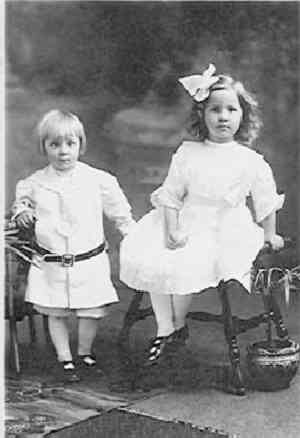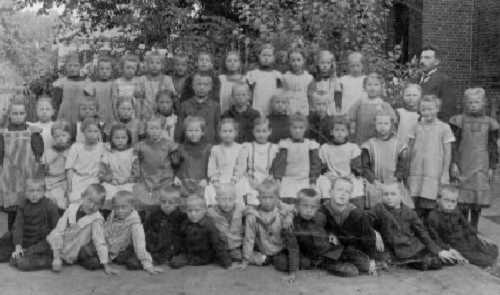
Boys' Hair: National Styles

Figure 1.--One of the most popular hair styles for younger boys were Dutch boy bangs worn with Buster Brown or other tunic suits. The comination was so strong that the hair style began known as Buster Brown bangs. The children were Arthur and Elsie and the photograph was taken in 1914.
|
Some boys hair styles are particularly associated with specifically associated ith indovidual countries. Some styles are generiv and worn in many countries. Long
uncurled hair was worn by French boys while ringle curls were most common in America. Flats tops and crew cuts were once standard American styles. German
boys once commonly had closed cropped hair. I'm not sure if Dutch boys bangs was once a common Dutch style, but presumably it was.
Countries
Here is some kimited information about boys' hair styles on various countries.
America
American boys commonly wore short hair during the 19th century. Ringle curls were worn during the Fauntleroy craze of the late 19th century and were more common than in Europe. Most boys American boys wore short hair, but the number who sported ringlet curls was considerable. As Fauntleroy ringlet curls declined in popularity during the early 20th cntury, many mothers adopted Dutch boy bangs for the boys wearing Buster Brown and other tunic suits. Flats tops and crew cuts became standard American styles after World War II as many men had become accusyomed to short military haircuts during the War.
England
Short hair cuts appear to have become standard for English boys by the turn of the 19th century. Younger boys might be kept by their mothers in curls. Boys educated at home might be kept in long hair, if their mothers thought that stylish. The ringlet curls American boys wore in the late 19th century were less common in Britain. Boys would have their hair cut short before being sent off to school. Short back and sides were a common hair cut at English private schools.
Some special styles have been reported by British observers. Mayhew in London Characters and Crooks, a fascinating volume of first-hand accounts of the poor and working-classes of Victorian London. He
describes the fashion of the working-class coster-boys (street stall sellers) of wearing their hair long in front. It is interesting to note that these boys, though living on the bread line, were as particular about their dandyfied hair styles as the teddy-boys, punks or fashion-conscious child of the 21st-century.
"Coaster boys in Victorian London"
...They all of them delight in dressing ‘flash’ as they call it. They try to dress like the men, with large pockets in their cord jackets and plenty of them. Their trousers too must fit tight at the knee, and their boots they like as good as possible. A good ‘king’s-man’, a plush skull cap, and a seam down the trousers are the great points of ambition with the coster-boys.
A lad of about fourteen informed me that “brass buttons, like a huntsman’s, with foxes’ heads on ‘em, looked stunning flash, and the gals liked ‘em’” As for the hair, they say it ought to be long in front, and done in ‘figure-six’ curls, or twisted back to the ear ‘Newgate-knocker style’ [the fashion for wearing a lock of hair like the figure 6 twisted from the forehead to behind the ear was then at its height.] “But the worst of hair is,” they add, that it is always getting cut off in quod [prison], all along of muzzling [hitting in the mouth] the bobbies.
One lad that I spoke to... was a tall stout boy, about sixteen years old, with a face utterly vacant. His two heavy lead-coloured eyes stared unmeaningly at me, and, beyond a constant anxiety to keep his front lock curled on his cheek, he did not exhibit the slightest trace of feeling. [Henry Mayhew, London Characters and Crooks, 1851, Reprinted by the Folio Society, 1996]
Many French boys in the 19th century wore long hair. HBC is unsure about the chronology. Boys in the eraly 19th century wore short hair. I'm not sure when long hair became more common. Long hair This was particularly popular among boys from affluent families. Boys from working-class families were more likely to have short hair. Long uncurled hair was worn by French boys. The ringlets that were commonly worn by American boys with long hair were much less common in France. As a result, the long hair worn by French boys often looks unkept. Perhaps for this reason, hair bows were more common for boys than in other countries. After the turn of the 20th century, long hair declined in popularity. Boys that did continue to wear long hair tended to wear it at lengths well above the shoulder.

Figure 2.--Even younger school boys often had closely cropped hair. This school photograph was taken in 1913.
|
HBC has at this time only limited information on hair styles worn by German boys. German boys have worn a variety of hair styles. Virtually no information is available on early 19th century styles. In the late 19th century, many school boys appeared to have had their hair shaved. HBC has noted that this style continued into the early 20th century, especially in the era during and before World War I (1914-18) often wore closely cropped hair. This style
continued simewhat into the 1920s, but was little seen by the 1930s. Apparently this rather military-inspired style was not of intetest to the NAZIs. Perhaps for the same reason that they did not introduce school uniforms. The long hair styles worn by some French and American boys do not seem to have been as popular in Germany. In the early 20th century, Dutch boy bangs (probably called page boy cuts) were popular for younger boys. This style appeared again in the 1970s--perhaps one of the many cultural impacts of the Beatles.
Italy
No information available at this time.
HBC has little information on the hair styles worn by Dutch boys. At this
time it is believed that they were rather similar to the hair styles worn by
German boys. One well known style are Dutch boy bangs. HBC is
unsure, however, what the origin of this hair style and just what the
association with the Netherlands, if any, is. HBC has noted modern Dutch
boys wearing bangs, but they do not seem to be especially popular. Most
available images show Dutch boys wearing a variety of other styles. In the
early 20th century the style was more common, although the term "Dutch
boy bangs" is an American or English term--unknown in the Netherlands.
HBC is not sure if there is a similar term in other European languages like
Italian or Spanish. The style with bobbed hair is calle "pagekopje" in
Dutch. It is similar to a "page boy" hair cut. Page is the word we use for
the boy who assisted or served a knight in the Middle-Ages. These pages
are often pictured with this hair-cut. "Kopje" means head. This style was
popular for a long time for young boys (first quarter of the 20th century).
Older boys revived it in the early 1970s--probably mimicking the Beatles
as in America and other European countries.
Russia
Russian school boys in the early 20th century are also commonly seen with shaved heads.
Personal Experiences
Here are some personal experiences regarding hair styles noted in various countries.
An American boy from a cathloic famuly in Rhode Island during the 1940s and 50s describes the hair styles that he remembers.
Christopher Wagner

Navigate the Boys' Historical Clothing hair style pages:
[Return to the Main hair page]
[Return to the Main Long hair page]
[Bangs]
[Ringlet curls]
[Hair bows]
[Curls]
[Caps]
[Collar bows]
Navigate the Boys' Historical Clothing Web Site:
[Introduction]
[Activities]
[Bibliographies]
[Biographies]
[Chronology]
[Clothing styles]
[Contributions]
[Countries]
[Boys' Clothing Home]
Created: March 20, 2000
Last edited: March 5, 2001




